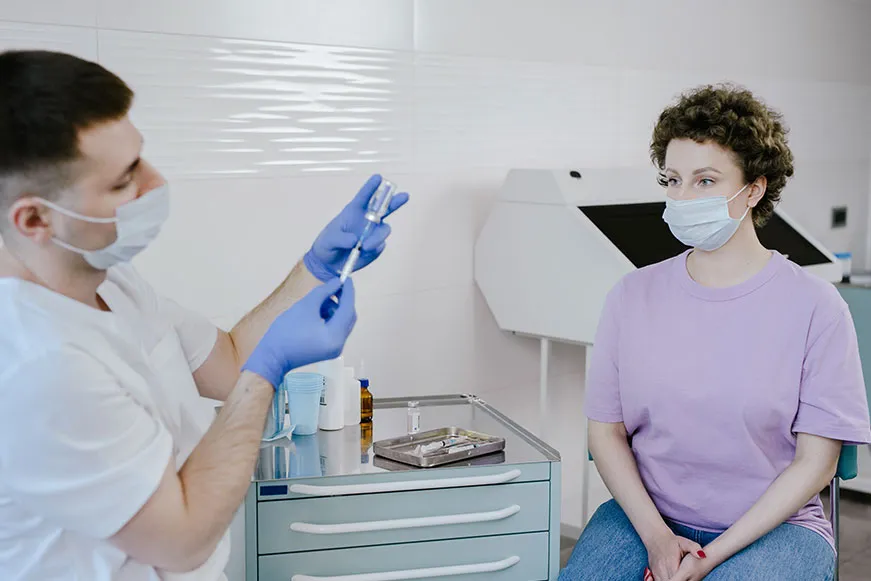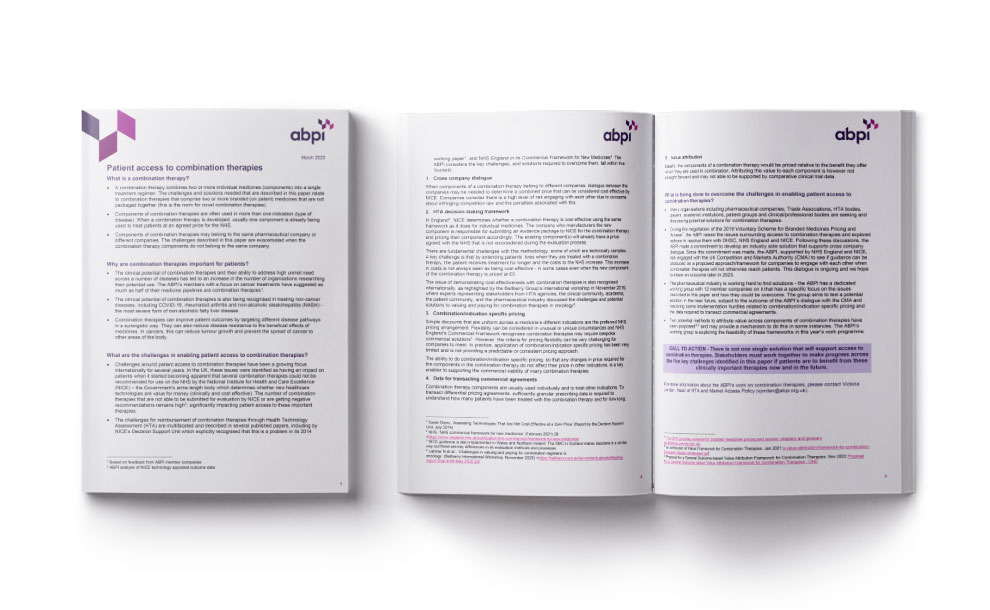Patient access to combination therapies

UK competition authority unlocks the door to more transformative combination therapies
In a world first, the UK Competition and Markets Authority (CMA) has released a statement which will support pharmaceutical companies working together on access to clinically important combination therapies.
What is a combination therapy?
- A combination therapy combines two or more individual medicines (components) into a single treatment regimen. These components are often used in more than one type of disease (indication).
- Combination therapies can improve patient outcomes by targeting different disease pathways in a synergistic way. They can also reduce disease resistance to medicines which means they may work for longer. For example, in reducing cancer tumour growth or preventing the spread of cancer around the body.
- Components of combination therapies may belong to the same pharmaceutical company or different companies. This situation can sometimes lead to challenges in licencing and pricing of these therapies.

Why are combination therapies important for patients?
- The clinical potential of combination therapies and their ability to address high unmet need across a number of diseases has led to an increase in the number of organisations researching their potential use. The ABPI’s members with a focus on cancer treatments have suggested as much as half of their medicine pipelines are combination therapies [1].
- The clinical potential of combination therapies is also being recognised in treating non-cancer diseases, including COVID-19, rheumatoid arthritis and non-alcoholic steatohepatitis (NASH) - the most severe form of non-alcoholic fatty liver disease.
What are the challenges in enabling patient access to combination therapies?
- Challenges around patient access to combination therapies have been a growing focus internationally for several years, but often stem from the difficulty of pricing and assessing cost-effectiveness of treatment.
- The challenges for reimbursement of combination therapies through Health Technology Assessment (HTA) are multifaceted and described in several published papers, including by NICE’s Decision Support Unit which explicitly recognised that this is a problem in its 2014 working paper[2], and NHS England in its Commercial Framework for New Medicines[3].
- There is not one single solution that will support access to combination therapies. Stakeholders must work together to make progress across the five key challenges identified below if patients are to benefit from these clinically important therapies now and in the future.
1. Cross company dialogue
In the UK, when the medicines in a combination therapy belong to different companies, dialogue between the companies may be needed to determine a price that can be proposed to the National Institute for Health and Care Excellence (NICE) – the Government’s arms-length body which determines whether new medicines are value for money (clinically and cost effective). However, companies consider there to be a high level of risk in doing this, due to concerns about infringing competition law. Further guidance is needed to support pharmaceutical companies.
2. Health Technology Assessment (HTA) decision making frameworks
In England[8], NICE determines whether a combination therapy is cost effective using the same framework as it does for individual medicines. The company who manufacturers the new component is responsible for submitting an evidence package to NICE for the combination therapy and pricing their component accordingly. The existing component(s) will already have a price agreed with the NHS that is not reconsidered during the evaluation process.
There are fundamental challenges with this methodology, some of which are technically complex. A key challenge is that by extending patients’ lives when they are treated with a combination therapy, the patient receives treatment for longer and the costs to the NHS increase. This increase in costs is not always seen as being cost effective - in some cases even when the new component of the combination therapy is priced at £0.
The issue of demonstrating cost effectiveness with combination therapies is also recognised internationally, as highlighted by the Bellberry Group’s international workshop in November 2019, where experts representing stakeholders from HTA agencies, the clinical community, academia, the patient community, and the pharmaceutical industry discussed the challenges and potential solutions to valuing and paying for combination therapies in oncology[9].
3. Combination/indication specific pricing
Simple discounts that are uniform across a medicine’s different indications are the preferred NHS pricing arrangement. Flexibility can be considered in unusual or unique circumstances and NHS England’s Commercial Framework recognises combination therapies may require bespoke commercial solutions[3]. However, the criteria for pricing flexibility can be very challenging for companies to meet. In practice, application of combination/indication specific pricing has been very limited and is not providing a predictable or consistent pricing approach.
The ability to do combination/indication specific pricing, so that any changes in price required for the components in the combination therapy do not affect their price in other indications, is a key enabler to supporting the commercial viability of many combination therapies.
4. Data for transacting commercial agreements
Combination therapy components are usually used individually and to treat other indications. To transact differential pricing agreements, sufficiently granular prescribing data is required to understand how many patients have been treated with the combination therapy and for how long.
5. Value attribution
Ideally, the components of a combination therapy would be priced relative to the benefit they offer when they are used in combination. Attributing this value to each component is however not straight forward and may not able to be supported by comparative clinical trial data.

What is being done to overcome the challenges in enabling patient access to combination therapies?
- Many organisations including pharmaceutical companies, Trade Associations, HTA bodies, payers, academic institutions, patient groups and clinical/professional bodies are seeking and discussing potential solutions for combination therapies.
- During the negotiation of the 2019 Voluntary Scheme for Branded Medicines Pricing and Access[10], the ABPI raised the issues surrounding access to combination therapies and explored options to resolve them with DHSC, NHS England and NICE. Following these discussions, the ABPI made a commitment to develop an industry side solution that supports cross company dialogue. Since this commitment was made, the ABPI, supported by NHS England and NICE, has engaged with the UK Competition and Markets Authority (CMA) to see if guidance can be produced on a proposed approach/framework for companies to engage with each other when combination therapies will not otherwise reach patients.
- The pharmaceutical industry is working hard to find solutions - the ABPI has a dedicated working group with 12 member companies on it that has a specific focus on the issues described in this paper and how they could be overcome. The group aims to test a potential solution in the near future, subject to the outcome of the ABPI’s dialogue with the CMA and resolving some implementation hurdles related to combination/indication specific pricing and the data required to transact commercial agreements.
- Two potential methods to attribute value across components of combination therapies have been proposed[11] [12], and may provide a mechanism to do this in some instances. The ABPI’s working group is exploring the feasibility of these frameworks in this year’s work programme.

CALL TO ACTION - There is not one single solution that will support access to combination therapies. Stakeholders must work together to make progress across the five key challenges identified in this paper if patients are to benefit from these clinically important therapies now and in the future.
For more information about the ABPI’s work on combination therapies, please contact Paul Catchpole, ABPI Director, Value and Access Policy PCatchpole@abpi.org.uk

Patient access to combination therapies
There is not one single solution that will support access to combination therapies.
Stakeholders must work together to make progress across the five key challenges identified in this paper if patients are to benefit from these clinically important therapies now and in the future.
References
[1] Based on feedback from ABPI member companies
[2] Sarah Davis, ‘Assessing Technologies That Are Not Cost-Effective at a Zero Price’ (Report by the Decision Support Unit, July 2014)
[3] NHS, ‘NHS commercial framework for new medicines’ (February 2021) 28. https://www.england.nhs.uk/publication/nhs-commercial-framework-for-new-medicines/
[8] NICE guidance is also implemented in Wales and Northern Ireland. The SMC in Scotland makes decisions in a similar way but there are key differences in its evaluation methods and processes.
[9] Latimer N et al., ‘Challenges in valuing and paying for combination regimens in oncology’ (Bellberry International Workshop, November 2020) https://bellberry.com.au/wp-content/uploads/Meeting-report-final-draft-May-2020.pdf
[11] An Attribution of Value Framework for Combination Therapies. Jan 2021 a-value-attribution-framework-for-combination-therapies-takeda-whitepaper.pdf
[12] Proposal for a General Outcome-based Value Attribution Framework for Combination Therapies. Nov 2022 Proposal for a General Outcome-based Value Attribution Framework for Combination Therapies - OHE
Last modified: 23 May 2024
Last reviewed: 23 May 2024